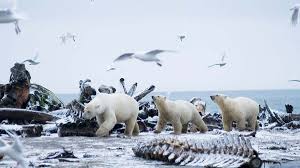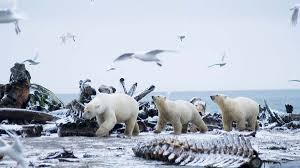
Introduction
As the effects of climate change intensify, polar bears are increasingly encountering human settlements, leading to more frequent and dangerous interactions. This emerging trend is driven by the rapid loss of sea ice, which is crucial for polar bears’ hunting and survival. This report explores how the climate crisis is pushing polar bears into human territories, the implications for both bears and people, and potential strategies for managing these conflicts.
Table of Contents
The Climate Crisis and Polar Bears
Impact of Climate Change
Climate change is causing unprecedented warming in the Arctic, leading to the rapid melting of sea ice. For polar bears, who rely on sea ice to hunt seals— their primary food source—this loss is critical. As the ice recedes earlier in the spring and forms later in the fall, polar bears are forced to spend more time on land, where food resources are scarce.
Adaptation Challenges
Polar bears are adapting to the shrinking ice by traveling longer distances and spending more time in areas that are not their traditional hunting grounds. This adaptation has brought them into closer contact with human settlements, particularly in northern communities where the bears are seeking alternative sources of food.
Human-Wildlife Conflicts
Increased Encounters
With diminishing ice cover, polar bears are venturing into populated areas more frequently. Reports from Arctic communities indicate a rise in polar bear sightings and encounters in towns and villages. These interactions can be dangerous, as polar bears are large predators with the potential to cause harm.
Damage and Risks
- Property Damage: Polar bears searching for food have caused significant damage to property, including breaking into homes, businesses, and waste facilities. This not only poses safety risks but also results in costly repairs and increased management expenses for affected communities.
- Human Safety: The presence of polar bears in residential areas raises serious safety concerns. Attacks on humans, while rare, can be deadly, and the threat of such encounters forces communities to implement stringent safety measures.
- Disruption to Local Life: Increased polar bear activity disrupts daily life in affected communities. Schools, businesses, and outdoor activities are often interrupted or canceled to ensure safety, impacting local economies and community well-being.
Responses and Management Strategies
Community Measures
- Bear-Proof Infrastructure: To mitigate conflicts, communities are investing in bear-proof waste containers, securing food sources, and improving infrastructure to prevent bears from accessing human settlements.
- Education and Awareness: Local authorities are focusing on educating residents about polar bear safety, including how to respond to bear encounters and the importance of securing food and garbage.
- Bear Deterrents: Non-lethal deterrents such as bear sprays, noise devices, and electric fences are being used to discourage polar bears from approaching populated areas.
Government and Conservation Efforts
- Monitoring and Research: Governments and conservation organizations are conducting research to better understand polar bear behavior and migration patterns. This data helps in predicting bear movements and implementing proactive measures to prevent conflicts.
- Policy and Regulation: Policies are being developed to manage human-wildlife interactions more effectively. This includes regulations on land use, waste management, and emergency response protocols to address polar bear encounters.
- Climate Action: Addressing the root cause of the problem—climate change—is crucial for long-term solutions. Efforts to reduce greenhouse gas emissions and mitigate climate change impacts are essential to halt the loss of sea ice and preserve polar bear habitats.
The Broader Implications
Impact on Polar Bear Populations
The increasing frequency of human-polar bear interactions is also affecting polar bear populations. While polar bears are resilient, the combination of reduced sea ice and increased human contact can stress populations, potentially impacting their health and survival rates.
Implications for Arctic Communities
For Arctic communities, the changing dynamics between humans and polar bears highlight the broader impacts of climate change on traditional ways of life. The need to balance conservation efforts with human safety and livelihoods is becoming more pressing as the climate crisis intensifies.
Conclusion
The collision course between polar bears and human settlements is a stark illustration of the far-reaching impacts of climate change. As sea ice continues to melt, polar bears are increasingly forced into human territories, leading to more frequent and dangerous encounters. Addressing this issue requires a multifaceted approach that includes improving community safety measures, investing in research and conservation efforts, and taking decisive action to combat climate change. By understanding and addressing the root causes of these conflicts, we can work towards solutions that protect both polar bears and human communities.








